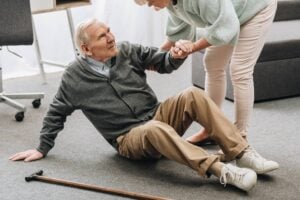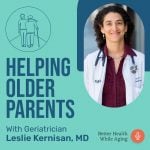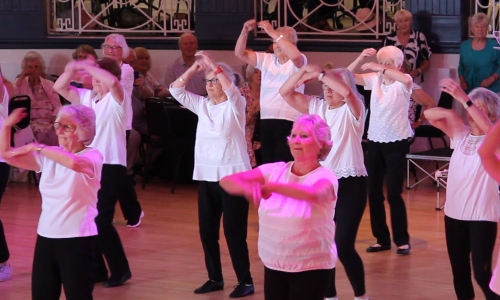
 Why do aging adults fall? To be honest, people don’t usually ask me this.
Why do aging adults fall? To be honest, people don’t usually ask me this.
Instead, they want to know things like “How do I keep my mother from falling?” or “What should I do? My grandfather’s been falling.”
After all, falls are a scary thing. Most people know that falls are dangerous for older adults.
The Center for Disease Control (CDC) reports that one in five falls causes a serious injury such as a broken bone or head injury. Fear of falling can also seriously affect an aging adult’s quality of life and sadly, can keep a person from being active and thriving.
So, many older adults and family caregivers are interested in fall prevention because the risks are so great. (According to Google, “balance exercises for seniors” is a popular search query; I do like balance exercises in aging, especially when combined with strength training and other exercises.)
And the good news is that although it’s not possible to prevent all falls, it almost always IS possible to take actions that will reduce the chance of a bad fall.
And it’s easier to take action once we understand more about why an older person has fallen.
If you want to learn more, you’re in the right place. In this article, I’ll cover:
- How understanding why aging adults fall can help you keep an older parent — or yourself — safer,
- Why personalized fall prevention plans work better than relying on general fall prevention tips,
- The four-step process I use to help older adults prevent falls,
- A practical example showing you how to use these steps to avoid falls yourself.
First, understand why older people fall
There are many reasons that aging adults fall. Most older people will be falling due to their own unique combination of reasons.
So how, exactly, should YOU go about reducing fall risk?
Now, you can — and should — try to implement the general tips that are often listed in most fall prevention resources: exercise, medication review with the doctor, vision checks, and home safety reviews.
But if you really want to help an older loved one avoid falls, I recommend you learn to better understand why he or she, in particular, might fall.
Why? Because when you understand the specific reasons an older person may be falling, you’ll then be able to:
- Identify which fall prevention strategies are most likely to help the person you worry about,
- Recognize risky situations, and take steps to avoid them,
- Know which medical conditions — and which medications — to ask your doctors to look into,
- Understand what may have caused a specific fall, which can help you avoid future falls.
In other words, learning why older people fall means that you’ll be able to figure out why YOUR older relative is likely to fall — and take steps to help them.
Why personalized fall prevention works better than general fall prevention
Once you understand the particular factors contributing to your older loved one’s risk, it will be easier to focus on the fall prevention strategies that are most relevant to your situation. In other words, you’ll be able to personalize your approach to fall prevention.
Personalizing fall prevention is critical. You don’t want your mom to start by spending a lot of time on tai chi or some form of balance exercise for seniors, if her current major risk for falls might be that her blood pressure medications are too strong, or her eyesight is terrible.
Also, don’t assume that most doctors will identify and manage the most important risk factors for falls. In my experience, busy doctors often miss opportunities to reduce fall risk, unless a family is proactive in asking for the right kind of help.
Now that we’ve covered how understanding falls can help you, let’s talk about falls. First, I’ll explain why any fall happens. Then I’ll share my framework for understanding why a particular older person might fall.
Why a fall happens
Why does a fall happen? Fundamentally, no matter who you are and what age you are, here’s why:
Challenge to balance or strength > Ability to stay upright”
In other words, we fall when we experience some kind of event that challenges our balance or strength. If this event overwhelms our ability to remain upright, down we go.
When we’re young and healthy, we tend to have lots of ability to stay upright. So if we stumble, we can often catch ourselves and recover before we fall. But of course, a big enough knock off-balance will send even a 20-year-old sprawling. And if that 20-year-old happens to be tipsy, it will take even less of a trigger to provoke a fall.
Illness or weakness is another situation that will reduce anyone’s ability to stay upright. (This is why people of all ages are prone to fall in the hospital.) But of course, older adults often have many other things going on which affect their ability to stay on their feet.
4 Steps to Reduce Fall Risk
Falls in older people are almost always “multifactorial.” This means there are usually several factors that are contributing to a fall, or to a person’s fall risk.
It can be hard to try to address every single factor. And some, such as slower reflexes, may be impossible to reverse.
Still, it’s often useful to go through them and try to spot a few that are either easy to fix, or potentially offer a big reduction in fall risk.
As a geriatrician, here’s what I do:
- Create a list of factors contributing to an individual older person’s fall risk.
- Identify risk factors and triggers related to recent or recurrent falls.
- Identify the factors that are easiest to modify or change. This is partly about the factor itself, and partly about what’s feasible for my patient to try to change. (Stairs can be a risk, but changing houses can be tricky.)
- Implement practical strategies to address modifiable fall risk factors.
3 types of fall risk factors you should consider
I also find it helpful to think of the factors as belonging to one of three categories:
- Health-based risks. This includes things like balance problems, weakness, chronic illnesses, vision problems, and medication side-effects. They are specific to an individual person.
- Environmental risks. These are things like home hazards (e.g. loose throw rugs), outside hazards (e.g. icy sidewalks), or risky footwear (e.g. high heels). This category can also include improper use of a walker, cane, or other assistive device.
- Triggers: These are the sudden or occasional events that cause a challenge to balance or strength. They can be things like a strong dog pulling on a leash, or even health-related events like a moment of low blood sugar (hypoglycemia) in a person with diabetes.
Now, you will probably find it hard to make a list of all these factors on your own. The health-based factors, in particular, tend to be closely related to medical problems. So they can be hard to properly sort out unless you’ve learned a lot about medicine.
Still, I encourage older adults and family caregivers to learn to think about fall risk factors, since this can help people get better at asking their doctors the right questions.
It’s also a good idea to ask lots of questions after a fall. You can learn more about what to ask here: 8 Things to Have the Doctor Check After an Aging Person Falls.
Example: Why is Mr. Jones falling?
Let’s consider an example together, to illustrate how you can put this understanding to work.
Mr. Jones is 82 years old. He lives at home with his wife, and takes a daily walk in his neighborhood. He has had diabetes for a long time, and has chronic numbness in his feet. He is on medication for diabetes, high blood pressure, and also uses Tylenol PM.
His daughter Wendy subscribes to a newsletter about elder care, and she recently read the CDC’s fact sheet on how important fall prevention is. Her father has had a few falls, which has made Wendy concerned. She would like to keep her father from falling.
What should Wendy do? As I mentioned earlier, the usual recommendations to lower fall risk are a good place to start. So Wendy could encourage her father to remain physically active and do balance exercises, and she might want to take a closer look at the house to remove common trip hazards.
She might also want to help him get evaluated for vision problems and for low leg strength, since these are common fall risk factors among people Mr. Jones’ age. Furthermore, diabetes can cause or worsen vision problems.
But if Wendy wants to personalize the fall prevention plan, she should also consider asking the doctor to help make a list of Mr. Jones’ health-based risk factors.
In Mr. Jones’ case, some additional factors that jump out at me are:
- Chronic numbness in feet. This is a common problem in people who have had diabetes for a long time, and it can definitely affect how easily people stay on their feet.
- It’s good to be aware of this risk, however, this problem usually can’t be cured or reversed.
- Diabetes. Some people with diabetes are prone to episodes of low blood sugar (hypoglycemia), especially if they take insulin or other drugs to actively lower blood sugar.
- Wendy could ask her father if he ever has low blood sugar episodes, which could trigger a fall. If he does, she should make sure this is addressed with the doctor.
- It is often appropriate to relax blood sugar control as people become older and frailer. This is because as people age, tight control brings fewer benefits but more risks.
- Blood pressure medication. This could increase fall risk, especially if Mr. Jones’ blood pressure is often below 120/80.
- Tylenol PM. Any over-the-counter medication labeled “PM” contains a sedative, usually in the form of an antihistamine such as diphenhydramine (brand name Benadryl). Older adults are often sensitive to these drugs, which can worsen balance or even thinking.
- Wendy should help her father review his medications. She should focus on spotting sedatives or any other medications with strong “anticholinergic” effects, such as a medication for overactive bladder. (For a link to a good list of anticholinergic drugs to avoid, see this post.) All sedating or anticholinergic drugs increase fall risk, but doctors may forget to avoid or minimize them unless a family specifically requests this.
You may have noticed that in this example, I’ve particularly focused on medications.
That’s for three key reasons:
- Medications are among the most common causes of increased fall risk in older people.
- Medications are often a fixable risk factor, when it comes to falls in older adults.
- Medication-based risks are often missed by busy regular doctors. Family caregivers can make a big difference by being proactive in this area.
If you’re concerned that you or your older relative might be on medications that are increasing your fall risk, see this article: 10 Types of Medications to Review if You’re Concerned About Falling.
You can also learn more about how to prevent injuries from a fall here: 3 Ways to Prevent Injury From a Fall (Plus 3 Ways That Don’t Work as Well as You’d Think)
Take the next step: create a personalized fall prevention plan
Remember, older adults usually fall because a) multiple risk factors make them vulnerable to falling, and b) a stumble or moment of weakness triggers the actual fall.
Most fall risk factors are health-based, and are related to chronic medical conditions or medications. And then some fall risk factors are environmental, and involve the home or outside environment.
You can definitely reduce fall risk by encouraging strength and balance exercises, and by optimizing the home environment. (Learn more about good strength and balance exercises here: Videos Illustrating Otago Exercises for Fall Prevention.)
But you’ll be most effective in preventing falls if you can get your doctors to help you understand your loved one’s personal fall risk factors.
This way, you’ll be able to develop a more personalized fall prevention plan…one that targets the risks and vulnerabilities most relevant to your situation.
[This article was last updated by Dr. Kernisan in March 2024.]




